Witness Marcel Broodthaers
The docile aphorism
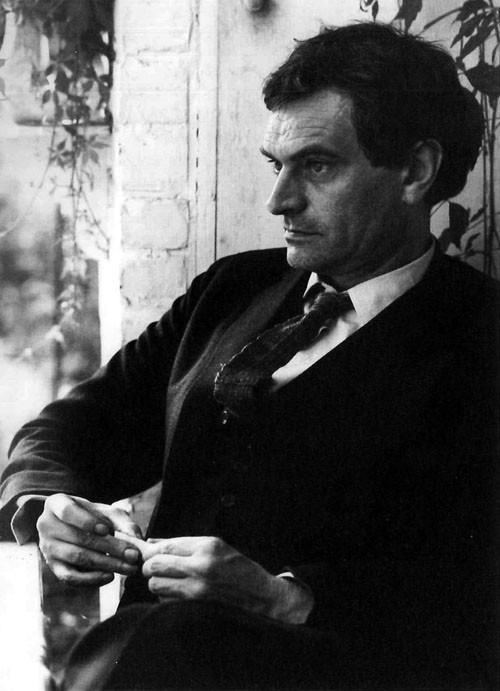
Poet, artist, composer and publisher Dick Higgins’ culminating work might be his 1987 study, Pattern Poetry: Guide to an Unknown Literature. The categories he draws up, and the drawing up of them, are as fascinating as the examples in this profusely illustrated book. Categories that replace received notions of prosody in visual terms call for new units of measure. Why replace? Because we equate poetry with verse, using the old would make the term “pattern poetry” redundant, short-circuiting its explanatory power. And it promises to have this power, make no mistake about that. The subtitle of the book is awfully enticing, or else it is just arrogant. If you swipe clean what “literature” means, of course I would need guidance. It’s a good book for that. But it does stop short of what we know Higgins to be capable of. After all, it was Higgins who gave us the generic moniker: intermedia. And he gave it to us with the feeling that when traits add up to a genre, it is less because they belong to it and more an indication that they are indefinitely modular. It’s like there wouldn’t have been a language to remember the 60s by without this. But it is a virtue of Pattern Poetry that it uses an old, familiar lexicon to approach the need for new categories. Indeed the lowest threshold for pattern poetry as a genre is that the “text fills in the visual form as opposed to having been superimposed over an earlier text.” Verbo-visual palimpsest, or superimposition, won’t suffice. That rules out a lot. A timeline can be constructed accordingly, and that is how the “guide” is organized. There is a definite wrinkle in time, though.
Higgins argues that before the 20th century the inherently visual form of an alphabet subordinated the pictorial component or “visual form” of a poem to strictly literary considerations. The guide concludes by reiterating this textual initiative: “A pattern poem is a poem, first and foremost.” Usually mimetic and assumptively musical, pattern and verse retrofit nicely to Higgins’ more famous designation of artworks as “intermedial” because the pattern poem had an air of inevitability about it, one that responded, for that matter, to what he describes as “an ongoing human wish” for the “the poet” to be “responsible for the visual element” and thus for an “aesthetic whole.” Anything otherwise motived becomes everything else: shaped prose, e.g. inspirational and commercial messages that stare one down in anterooms and pedestrian thoroughfares. Now the wrinkle. The trajectory of pattern poetry mostly elides modernism, even Symbolism, and specifically Mallarmé’s “Un Coup de dés jamais n'abolira le hasard.” That poem marks the end of an era, the era of pattern poetry’s suppression by neoclassical ideals of beauty and its place (or lack thereof) in the imparting of knowledge. Though it marks both the end of the timeline and the return of the repressed, it is not exactly in the tradition of pattern poetry, according to Higgins. It is not at all clear why we must arrive at Concrete Poetry before the tradition resumes. Or is resurrected. But it seems to have something to do with Higgins’ relegation of the line to what is most prosaic and habitual about verse; the line cannot itself be a pattern, a shape, or even an extension of “geometrical thinking.” Really?
The invitation to Exposition littéraire autour de Mallarmé. Click image to enlarge.
Writing about Marcel Broodthaers’ 1969 Exposition littéraire autour de Mallarmé, Rachel Haidu compares the ways in which the artist displays and disappears the poet’s language, “because the kind of dangerous and fecund reciprocity between advertising and poetry that Mallarmé invents and puts into motion is critical for Broodthaers.” She means “critical” in its most rigorous sense. This is the exhibit where Broodthaers’ famous “industrial poems” on vacuum formed plastic—like "oversized credit card[s]"—make their debut. Reading these in light of the strategies and effects of Pop Art, Haidu argues that the critique manages to meld different temporal frames to achieve the highest adjacency of looking to reading. By “reading” she means also “hearing.” The presence of Mallarmé historicizes “the reading-effects of [Broodthaers’] own era and the art that registers its processes,” foreshadowing his well-known impatience with the ways in which Conceptual Art seemed to denigrate literature. Broodthaers' work could be read in as Concrete Poetry, but that rarely happens. As he rose to prominence in the artworld of the time, and especially before the climactic period beginning with his fictive museums and ending with the "retrospectives" he called Décors, that is, at the end of the 60s, it was pitched as curious pastiche of Pop and neo-Surrealist sensibilities. Magritte serves as a hinge figure. Broodthaers’ debut publication as a poet came care of the Surrealist weekly Le Ciel Bleu, co-directed by another Marcel, Marcel Mariën, probably the best known Belgian surrealist after Magritte, whom he published also. It is useful to recall that now in light of how the admixture of impulses informs the difference between reading and hearing. Pace Haidu, if we question the equation of reading and hearing, we must complicate the division of reading and looking in terms of the presumptive “reading-effects” governed by prosody.
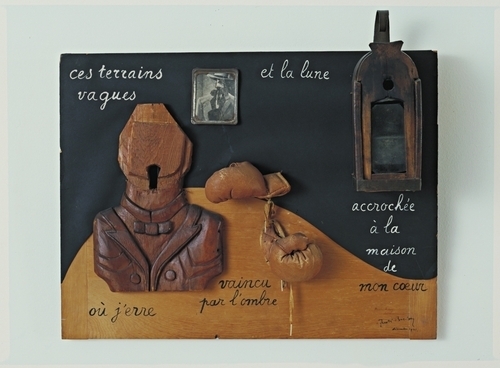
Andre Breton, Poem-Object (1941).
Surrealists and their descendents were more inventive than we tend to remember, when it comes to visual prosody. André Breton himself experimented with written objects in remarkable ways (relief sculptures were “poem-objects”), ways that help us negotiate Broodthaers’ appropriative strategies. These strategies might be baptized by the names Mallarmé and Magritte, then recirculated by Foucault in his essay “Non Affirmative Painting” and its recourse to the seriality of Warhol’s soup cans, another weird sacrament in the years when one still sought out the originality in the pallid "factory" of Pop. (Broodthaers then repurposes Foucault’s text as an artist’s book about an aborted non-collaboration between the two). The Situationists’ indictment of Surrealism matches the stridency of anything Breton ever wrote, and is particularly biting when it comes to the “convulsiveness of beauty.” As Raoul Vaneigem put it in his Cavalier History of Surrealism,
Metaphors, of which the whole of Surrealist poetry (in the narrow sense) is a many-splendored celebration, combine two sparks: the spark, produced by the interaction of contrasting assemblages, which destroys congealed language, and the spark, produced by the clash of subjective symbols, which creates new language. The two become one…
The system of metaphor and image in painting thus constituted an ideological ruse…whereby Surrealism successfully concealed both the bankruptcy of culture as a separate and alienating sphere and the corollary need to advance from the archaic notion of a living art to the reality of an art of living.
I would argue that if we inject the prosodic cue between language to be read and language to be looked at, between “metaphor and image,” the menace of “culture” as an atomizing force subsides considerably. In “Silence Is Golden,” Breton writes of the “marvelous” capacity of the metaphor, that it promises to reveal surprising anagrams, to make them “brave the light of day,” and disclose an “inner word” that sounds a lot like what Julia Kristeva would later dub the “chora” (in reference to Mallarmé, of course). He insisted that metaphor conveyed “thought which has kept…organic contact with music…by which it very probably is cradled and conditioned.” Kristeva removes all probability from this paradigm to distinguish the “semiotic” from the “thetic” (the sound from sense). But it is not just a typically modernist recourse to music that softens Vaneigem’s indictment enough to apply it to an affective critical methodology that Broodthaers would master in the still potent wake of Surrealism’s heroic phase. In Breton’s reflection on the reification of “great poets”—on what lengths “culture” goes to defang poetry’s grander enterprise—an important aside nuances the equivocal place of the “image” in metaphorical speech.
I have already protested against the designation “visionary” being lightly applied to poets. Great poets have been “auditives,” not visionaries. At least, with them, vision—“illumination”—is effect and not cause. I take Lautréamont literally in the following: “Come now music. Yes, good people, it is I who command you, on a spade reddened in the fire, to burn with brown sugar the duck of doubt with lips of vermouth…” These things, I believe, were seen only after they had been heard. This is what I meant when I wrote: “In poetry verbo-auditive automatism has always seemed to me the creator for the reader of visual images far surpassing in exaltation the visual images created for the reader by verbo-visual automatism.” Thinking that for painters it might be otherwise, I then tried to provoke their testimony on this point, but their avarice in the matter of confidences is well known.
Breton never really trusted the plastic arts to pull off the project of traversing the depth structure of reality, the way he did writers. So he resorts here to a stereotype; painters paint because they are jealous or the articulatory advantages of poetry. The stereotypical reticence of painters becomes a positive project when Magritte short-circuits the mutual impress of image and text (neither pipe nor statement about pipes). Like Lyotard in “The Sublime and the Avant-Garde,” you could say poetry has the advantage over painting, in that connotation and combination make the image only secondarily inventive, disharmonic, and thus poetry contains greater “shock effect.” The mind’s eye is utterly permissive. Higgins would seem to agree. What Broodthaers discovers in Mallarmé as found language (and stock image) is a suspicious weakness in this prejudice for which he himself had a special weakness. To make him a prototype is to exagerrate the threat to visual decorum or literary innovation that his most famous poem represents to this day. He is too much a Symbolist for radical modernism but too little a visual artist for Concrete Poetry. He can only be a signal of permission, a "chance" for something else to happen. But as a poet, Broodthaers didn't stand a chance. It seems he decided he could only carry on as one in the guise of an artist. Not unlike Breton, in certain moods.
The Belgian poet Freddy de Vree claims that Mallarmé’s Igitur “is the metaphor of the poet who has eliminated his subjectivity. Broodthaers was also bent upon this. Igitur is the author of a text, a story which generates itself…the image which makes us whirl around in associations.” One way Broodthaers disappears Mallarmé is to inscribe a coat hanger with the name Igitur and then, after the show opens, remove the coat (itself inscribed with lines from “Un Coup…”). Another is by alternating verb tenses between the affirmative, the negative and the conditional (in the film This Wouldn’t Be a Pipe). In the artist’s book addressing Foucault, Broodthaers writes, “What then is this form which I believe to be self-evident? The text ‘This is not a pipe’ is the equivalent of the painting, it could replace the sight of it. That is to say that the reproduction of paintings in this book constitutes a contradiction not on the level of a controversy but rather in terms of the structure of this book.” All under the rubric, printed as a heading in bold, italic script, “This is a pipe[.]” De Vree insists that “igitur” is “a [grammatical] conjunction,” a “thus,” a situated contingency. The epigraph to Mallarmé’s enigmatic tale is initialed “S.M.” and reads: “This Story is addressed to the Intelligence of the reader which stages things itself.” And rhymes with Broodthaers’ open letters, which routinely use the stock salutation, “To whom it may concern.” But it is not the reader so much as their “Intelligence” that imagines. We don’t “whirl around in associations”; it does. The problem is not the subject, but subjectivity. So when an object becomes the platform for literary activity, with no proper subject to respect, Broodthaers disturbs neither the integrity of verbal space nor the tempos of visual imagery. They perfectly commingle. I think this would explain his deep love, and knowledge, of cinema. His films, objects, and texts were most explicitly prosodic when they were superimposed, making it hard to talk about his visual prosody without wondering if there are one or several works involved. The difference between close reading and comparative approaches dissolves.
Monica de la Torre rightly claims that “The fictions of Broodthaers’s body of work, and the institutional critique running through them, had more to do with his manipulations of conditions of display than with the actual content of any particular piece." She has just let the work speak for itself by reproducing some of his poems in translation at the moment this claim occurs. Yet the poems have received close readings that suggest the opposite. A particularly good example can be found in Michael Compton’s “In Praise of the Subject." But then Haidu’s core claim is that language, and literary language at best, never ceased to be the paradigm for these conditions of display. Reading Haidu’s book, alongside the newly available Collected Writings, it’s possible to conclude that: The clever narrative he circulated to the galleries of Europe in the 1960s and 70s, all about turning his back on the world of letters for a sojourn in the life of the mind, is proof positive of both the dismal conditions of “Literature” as he viewed it then and the global ordinance of post-minimal and latter day Pop Art that precipitated his dis-playing of the museological “institution”—the institutionalization of the muse. By turning our attention to the locality of “any particular piece,” every last one appears to conduct the environment as an unconditional, or at least incontrovertible, singularity. To the point that, Broodthaers shows ultimately that the “piece” is organized like an aphorism
As a literary phenomenon, the aphorism is unique. It is replete, sufficient, and never dissipated by any attempt to repeat it. It has no context, because the text includes and concludes everything to which it refers. Its power is in its apparent docility. Only apparent, though: it’s a fiction. And such apparitions are what permit us to see a supplementary dimension. As Broodthaers put it, “I believe a fictitious museum like mine allows people to get a grasp of reality as well as what it conceals.” Fiction subtends the real. Standing in the Musée d’art moderne, that thesis is all we’re left to marvel at. Vis-a-vis the “marvelous,” Institutional Critique is invented as an unholy mix of modernist bluster and postmodern blather. But there is mixture, and then there is letting.
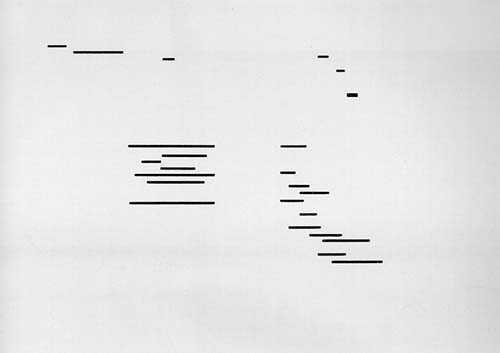
A spread from Un Coup de dés jamais n'abolira le hasard (image) by Marcel Broodthaers. The book was published in three formats, each of which was exhibited in his Exposition littéraire autour de Mallarmé.
Broodthaers’ Un Coup de des (image) guts the explanatory heft of Mallarmé’s poem by weighing down its stark contours of white, unused space on the page. This explains why it is, of all of his work except the industrial poems and Department of Eagles, always already overexplained the moment you comment upon it. The ineluctable absence that Mallarmé championed in “Crisis in Verse” likewise is overexplained by the slightest attention, distracting attention from the fact that it was firstly a reaction to a stalemate. Mallarmé is addressing the petrified prosodic conventions of the day. He had occasion to explain any deviance from them, but this exacerbated his love of concepts that replay and reverberate until an exquisite redundancy is reached—which has a kind of ideational metric, a cyclical one, and replaces the prosodic “foot” with the aphoristic wit(ness). Far from an explainer, Broodthaers, pace Magritte, disguised his project with a kind of docility, a limp disinterest, where even his interventionist gestures (semi-truck trailers parked out front, ushering a camel into the building, etc.) eschewed bombast or flamboyance. Broodthaers was a demystifier rather than an explainer, because he saw that, if signification lacked positive terms, this did not locate exegetical assurance in the absence of an object but the objective presence of thought. Broodthaers restores quiddity.
Broodthaers’ open letters seem exegetical on the face of it, but that is only their pretense. That is another “fiction.” In Does Writing Have a Future?, Vilém Flusser argues that “writing letters is closely related to writing poetry” in that grammar and orthography, crucial for communicating across a certain distance that made these communiques necessary in the first place, have as their counterparts “verse form[s] of rhyme pattern.” Both strictures can be characterized as “festive” insofar as they constitue rules that are “at once justifiable and absurd, both rigid and flexible.” The “informatic” future of writing, Flusser suggests, is the meta-pattern of poetry. Prosody remains as a way of slicing along the lines of a pattern that hails you, in two ways: by direct address, apostrophe, "to whom it may concern"; but its most insidious form of address is ventriloquism, recitation.
Broodthaers confronted the going concerns of the artworld by reciting them. Conceptualism: In a 1973 text that remained unpublished until the Collected Writings appeared in 2012, Broodthaers riffs off of Lawrence Weiner’s famous “Statement of Intent," concluding: “Since no one form is intrinsically superior to another, the artist can use any form whatsoever—from literary expression, either written or spoken, to physical reality—in equivalent fashion.” Pop Art (aka Nouveau Réalisme): “Such is the New Realism: a more direct way of getting the feet back on the ground, at this precise level where man, if he manages to reintegrate the real, identifies it with his own transcendence, which is pure emotion, feeling and ultimately poetry, still.” Elsewhere, in reference to Duchamp—our umbrella term for the swerved line running through the entire historical avant-garde, the prehistory of post-minimalist doxa, written under the heading “METHOD,” Broodthaers calls the analysis of a definition arrived at by artistic means a sort of writing—and what sort?—“sub-literature.” He digs at Joseph Kosuth’s logical positivism here also. Vis-a-vis the burgeoning field of the “artist’s book”: “an artist does not construct a volume. He writes a volume” These examples of Broodthaers’ celebrated “aphoristic wit” beg the question. Letting the answers proliferate easily, like dichotomies that self-ennumerate by counting themselves into their own logic. An aphorism has neither major nor minor premise. Its logic is intrinsic. Repeated by all, it stands for everyone. This is its singularity: immanent validation, instant affirmation. It is never repetitive because its outside is indifferent. By contrast, poetry without pattern (i.e. conventional verse) awaits us to conduct it, to “recite” it. Every example of the docile aphorism is rather that of recitation.
I will conclude by looking at a couple such instances in Broodthaers’ oeuvre. I’ll call them film-books because they were published as box sets containing a book and a reel of film. In the case of Voyage au mer nord (1974), that was exactly what you got. In the case of Le Corbeau et le renard (1967), the edition of 40 (of which only 7 were made) also contained, along with other ephemera, two prepared screens. One was framed. Both screens and frame were written or printed upon. The screens were to be used to screen the film yourself. The box was imprinted inside and out—there was something to read over every possible surface. It was literally and figuratively a “volume.” And we know that the flatter, the less volume text has, the more legible it is. Through concealment and multiplying dimensions, Broodthaers found he could imperil reading just by looking at words. As he put it in an interview the following year, “to see and be able to understand the total work that I have tried to make, not only must the film be projected on the printed screen, but the spectator must also have the text.” The text was ostensibly lifted right out of Fontaine’s fable, but it was altered in a way the documentarian wing of contemporary conceptual writing might appreciate (thinking here of Mark Nowak’s imbrications of grammars and activist leaflets). In Broodthaers’ own words: “clichés, borrowings from elementary writing lessons and personal inventions” form “poetry of a theoretical character.” He would also call it an “exercise in poetic reading,” and “an exercise in sentimental reading.” Ventriloquizing the Parisian champion of Pop Art in his day, Pierre Restany, Broodthaers wrote a text for an exhibition the same year as Le Corbeau et le renard. It is very funny. But its sentimentality runs deep enough to inform how we should read affect as an appropriative strategy. I think this is the salient passage because it links prosodic sensitivity (under the sign of orthography) to visual sensitization.
Broodthaers is pronounced Brotars: four useless letters in the spelling of a name. It’s enough to inspire in one the vocation to become a philologist, a paleographic archivist, an explorer-ethnographer. Broodthaers is all of these things at once, and more besides. Like Marat as seen by Sade, he carefully cultivates the eczema of language…
Our Second Industrial Revolution in the 20th century produced an excess of information and visual solicitations. The difference between poetry and the visual arts fades in the face of the problem of this excess of images that above all need sensitizing, humanizing, individualizing. Immersed up to his neck for 43 years in this sea of saturation of the mass media, Broodthaers is desperately seeking his reality, which is perhaps, in the end, other people’s art. Other people’s art conceived as reality itself.
Maybe the film-books ought to be considered “talkies,” but with the soundtrack inscribed by temporal discontinuity, rather than an audio track inherent to the film. Though Broodthaers expressed a desire to denude image and text, or render them vapid, the screen and film (or page and filmic image, for Voyage) would be required to synchronize and redouble the effort.
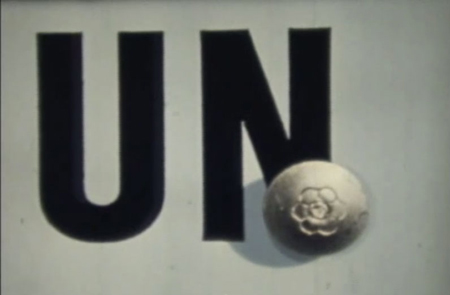
A still of the film running on a blank screen, derived from a screen capture of UBU Web, where you can view the film.
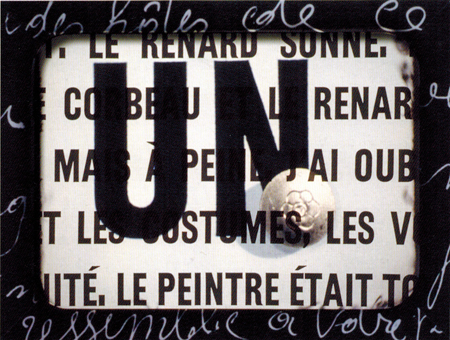
A still of the film running on the framed and printed screen. Broodthaers films the film running on a prepared screen and splices these shots into Cinéma modèle: programme La Fontaine (1970), which you can also view here, at UBU Web.
What readers lose in precision they gain in meaning. Meaning is even overdetermined by revealing proximity. Proximity is revealed not by precise superimposition but by a failure to accurately register. Kristin Ross analyzes the “truly bold” metaphors in Rimbaud similarly. To compare terms that belong to entirely different domains defies but does not distort either. But in phrases like “blue wine” and “green lips,” she locates socio-historically precise usages that reveal the poet to be affiliating with a common, marginal trope rather than hallucinating an eternal verity too true to be ordinary. Apparently outlandish metaphors in Rimbaud’s work are anything but rhetorical obfuscation or poetic license. The fictions they evoke are all that conceal the sense they make. This theory of metaphoric audacity is Surrealist in method but New Realist in its objective. It’s easy to confuse the two. When we think that the goal of A Season in Hell is “Christmas on Earth,” for example, we mistake a way of saying the obvious (how else does God husband an earthly estate?) with unleashing the chora.
Broodthaers’ use of other artists’ work is similarly down to earth. Such minimal distortions resonate with his conviction that the “distance” between poetry and “fine arts” is in the substance of the work, rather than in proprietary institutions (commercial and civic venues like museums, genres like poetry, media like cinema). A poem has no substance per se. Printing or otherwise displaying one disguises this fact. No effective disguise is perfect; the wearer must not become the monster they reveal themselves to be. And in launching a poem into what he called a “space” of “conquest,” the promise of kinetic wavering and inexact registration on either side of the text’s inert interval—between the book and its reader—carries out the fiction beneath the fiction. The overprinting of Pense-Bête is an excellent example of this, even before a batch of the books were encased in a sculpture. This sculpture is typically considered his inaugural "piece."
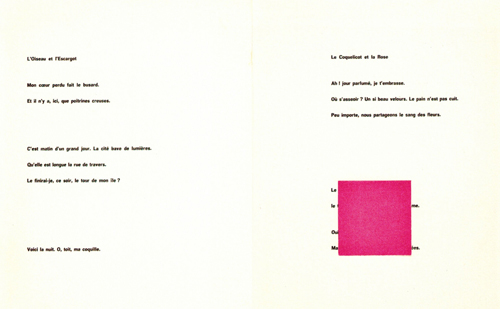
A spread from Pense-Bête, Broodthaers' last book of original poetry.
As is Petit rond, le renard, assembled in the same series as the film-book in question, with ink and watercolor, and affixed to plexiglass (overriding transparency once again).
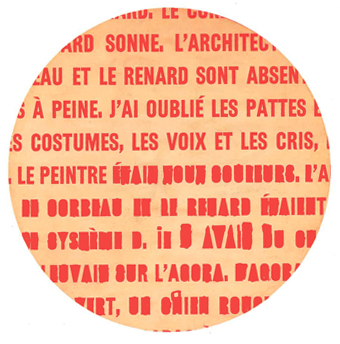
Petit rond, le renard (1967).
Another way to measure the distance between his first and last vocations would be, as he once put it simply, “heart,” or sincerity. “[T]he idea of inventing something insincere” marks his abandonment of poetry on the cusp of his acclaimed debut as a gallery artist. Heart, i.e. Rimbaud himself whom in 1966 he called, without any hint of irony, “the model of revolt.” Still he deftly negotiates the template. Rimbaud would flesh out perfect Parnassian quatrains like he was stuffing olives, and penetrate that pattern with incendiary remarks. Like an early neo-benshi or movie-talking prank, any pattern then is already underwritten. And long after it gives up its own exegesis, it is tamed, “neo-avantgarde.” Docent turned blue chip artist, Broodthaers revels in the critical industry he left behind.
In the Voyage book, we are advised to inquire elsewhere, somewhere over the rainbow, where “literature” and artworld buzz combine. Because it is at pains to distinguish itself from an artwork, the text as well as the book bearing it are allowed to assume the form of an ornament: “culture.” Here are the preface and postface of the book.
BEFORE CUTTING THE PAGES THE READER HAD BETTER BEWARE OF THE KNIFE HE WILL BE WEILDING FOR THE PURPOSE. SOONER THAN MAKE SUCH A GESUTRE I WOULD PREFER HIM TO HOLD BACK THAT WEAPON, DAGGER, PIECE OF OFFICE EQUIPMENT WHICH, SWIFT AS LIGHTNING, MIGHT TURN INTO AN INDEFINITE SKY. IT IS UP TO THE ATTENTIVE READER TO FIND OUT WHAT DEVILISH MOTIVE INSPIRED THIS BOOK’S PUBLICATION. TO THAT END HE MAY MAKE USE, IF NEED BE, OF SELECT READINGS FROM TODAY’S PROLIFIC OUTPUT. THESE PAGES MUST NOT BE CUT.
BEFORE CUTTING THE PAGES THE READER HAD BETTER BEWARE OF THE KNIFE HE WILL BE WEILDING FOR THE PURPOSE. SOONER THAN MAKE SUCH A GESTURE I WOULD PREFER HIM TO FLING AWAY THAT WEAPON, THAT DAGGER, WHICH, SWIFT AS A MIRACLE, MIGHT TURN INTO A PIECE OF OFFICE EQUIPMENT. THESE PAGES MUST NOT BE CUT. IT IS UP TO THE ATTENTIVE READER TO FIND OUT WHAT MOTIVE INSPIRED THIS BOOK’S PUBLICATION. TO THAT END HE MAY MAKE USE, IF NEED BE, OF SELECT READINGS FROM TODAY’S PROLIFIC OUTPUT. SEE CATALOGUES, PAPERS, REVUES.
Between these two statements are deliberately uncut spreads containing all of the visual information. One must peek inside. Carefully, though, so as not to deface the art object by activating the book. The film will duplicate the visual information with close up shots of the book’s innards. The model is a still from the film, filmed. This information in the book faces itself, like a screen: the last thing you see while staring at a film. Though it’s just what you look at.
Superimposing text on image is not "pattern poetry." In turn, what pattern poetry is is first and foremost text that exudes its own image. As in prosody, text that exudes its own "voice." Broodthaers uses superimposition to set registration off kilter, so that the fictive patterning of reality materializes. It materializes as poetry, but not only because it exhibits a kind of visual prosody.
- Andre Breton
- Andy Warhol
- Arthur Rimbaud
- Dick Higgins
- Freddy de Vree
- Jean-Francois Lyotard
- Joseph Kosuth
- Julia Kristeva
- Kristin Ross
- Lawrence Weiner
- Marcel Broodthaers
- Marcel Duchamp
- Marcel Marien
- Mark Nowak
- Michael Compton
- Michel Foucault
- Monica de la Torre
- Pierre Restany
- Rachel Haidu
- Raoul Vaneigem
- Rene Magritte
- Stéphane Mallarmé
- Vilem Flusser

Witness